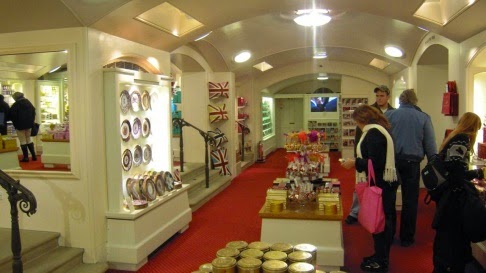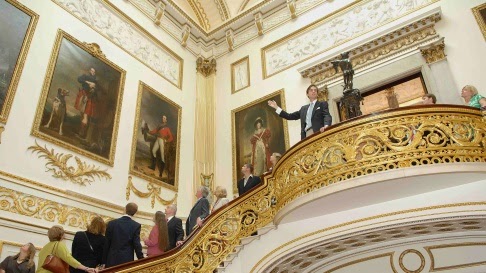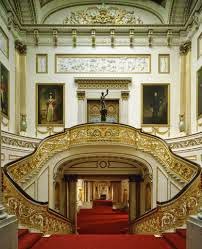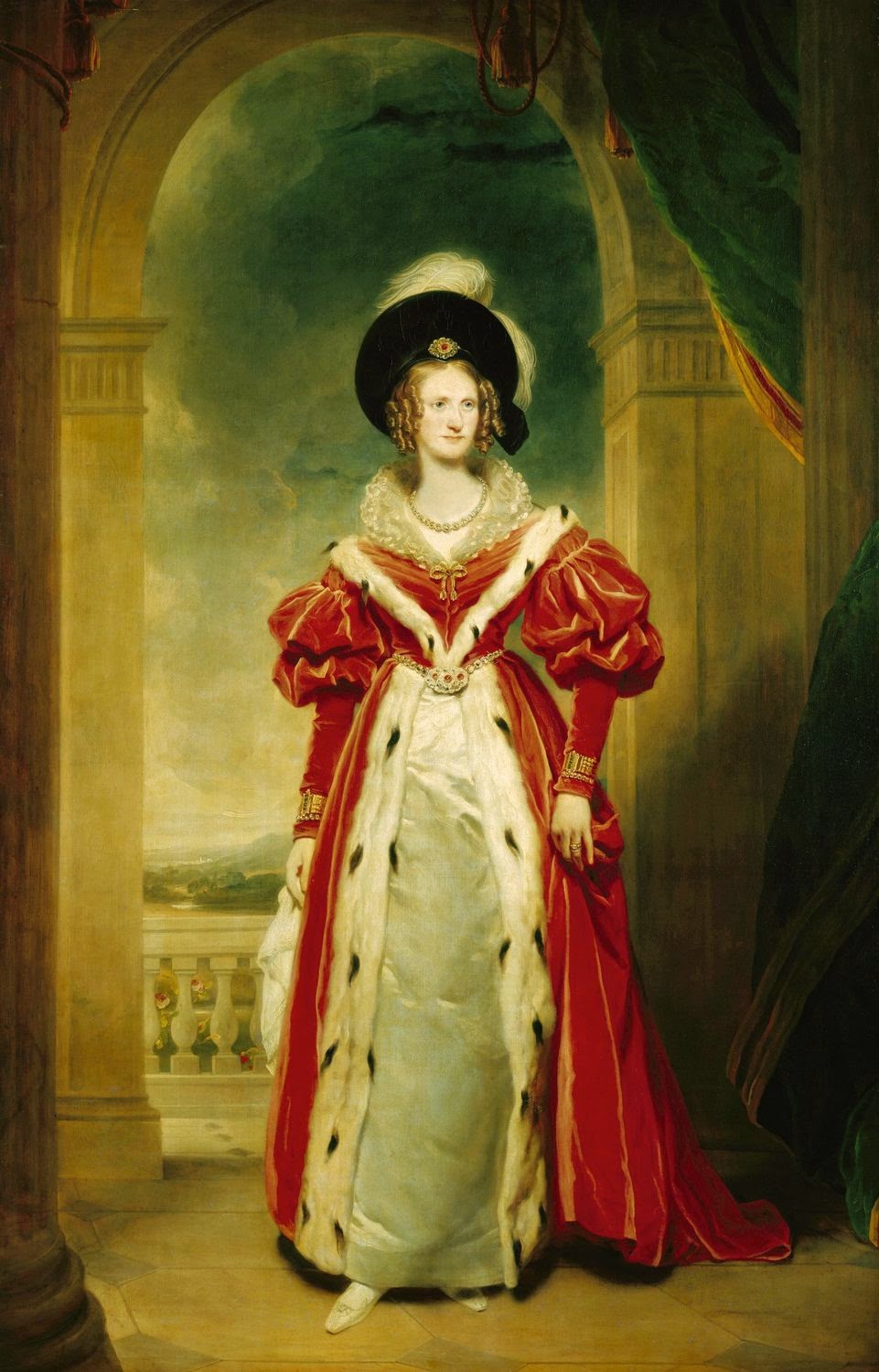Queen’s Gallery Gift Shop
So there I stood in the gift shop of the Queen’s Gallery Browsing. More browsing…downstairs to the facilities. Back up for more browsing…Ran into the Palace-uniformed woman who guided us around Clarence House on Sunday and we chat for a while. I go outside and sit in the shade. Then I sit in the sun. Go back inside…I know I am slow going through the exhibition and that I read every word of every text panel and label…so certainly I cannot be ahead of Kristine, Diane, and Marilyn by this much time. Where could they be?
Queen’s Gallery Entrance
Could I be paranoid enough to think they ditched me? That they went on to the Palace and are now enjoying a tete a tete with the Queen while I am just standing around? How long do I wait? I have my phone but Kristine doesn’t have a phone that works in England….I wait some more.
Eventually, after what seemed like hours, I walked to the entrance of the Palace itself, the tourist entrance, that is. No friends awaited me. I turned in my ticket and went inside to sit in the tent…but the guards suggested I move along. That I was waiting for friends seemed not to matter. I must have looked suspicious because the guards definitely stood nearby and glared at me.
Where were Marilyn, Diane, and Kristine? I started visualizing the three of them walking through the gilded halls and giggling mean-girl fashion, thinking of me waiting outside, never to see the Palace.
How dare they? Eventually, under prodding by the guards and because I didn’t want to sit around concocting scenarios in which I’d become the odd person out for the next two weeks and would have to tag along behind everyone else, I decided to forget about the situation and enjoy my trek through the Palace. Alone. Aren’t we all trapped by the trials and tribulations of our junior high school experiences?
Fortunately, I am easily diverted and soon, if momentarily, forgot about being the ditched kid.
Up the Grand Staircase
For a virtual tour of the Grand staircase, click here.
The Grand Staircase
In the manner of tourists everywhere, the crowd, while not immense, moved at varying rates of speed
some lingering to inspect various items or question the numerous uniformed guides, most of whom had ready answers for all the inquiries. The State Rooms are sumptuous, as you can tell from these pictures. They were decorated by Architect John Nash and George IV, who saw them as stage settings for the impressiveness of the King, the magnificence of the British monarchy.
The Green Drawing Room, Anteroom to The Throne Room
The Throne Room
The Throne Rom is the home of thrones used in many coronation ceremonies over the years, set about the room. Guides stated that the only time Queen Elizabeth II sat on her throne was for her 1952 Coronation. The room is used for various ceremonial purposes, but I guess nobody sits down!
The Blue Drawing Room
It is an ironic amusement to me that the decor was so heavily influenced by the French styles of the 18th century, the time of Louis XIV, XV, and XVI. Despite the fact that Britain and France were almost continually at war in this period, the British aristocracy and particularly the Prince of Wales, aka the Prince Regent and eventually George IV, adored French art, architecture, and workmanship. It set the standard for the world.
For a virtual tour of the Blue Drawing Room,
click here.
The White Drawing Room
The White Drawing Room is particularly elegant, with the lovely 1908 portrait of Queen Alexandra as the focal point.
Queen Alexandra (1844-1925), 1908, by Francois Flemeng (1856-1923)
According to the description in the Royal collection website, “This strikingly sophisticated and composed portrait of Queen Alexandra was painted by the French artist François Flameng in 1908. It is perhaps one the highlights of early 20th century royal portraiture. The Queen sits upon a stone step, she gazes directly at the viewer; dressed in a white silk dress, diaphanous gauze suggested about her arms and shoulders. She is wearing the riband and star of the Order of the Garter, a diamond choker, long string of pearls and small crown. A wooded landscape and suggestion of a building or castle in the background.”
For a virtual tour of the White Drawing Room,
click here.
The Music Room, overlooking the gardens
The Music Room is graced by large windows alternating with columns of scagliola made to resemble lapis lazuli. To read about a recent restoration of the columns by the firm of Hayles and Howe, c
lick here.
One of two chandeliers in the Music Room
Attributed to Perry and Co., 72 New Bond Street. and originally made c. 1815, the two chandeliers were probably created for Carlton House, and later altered and rehung in Buckingham Palace. They are said to resemble the the chandelier in the Piccadilly Drawing Room at Apsley House, London. We shall see!
The Ballroom, arranged for a formal dinner
Most of the State Rooms were originally decorated by Nash and George IV, but later changes were made by Queen Victoria, such as the building of this large ballroom in 1856. When I was there in September, 2014, it was arranged as the main exhibition area for the Royal Childhood exhibition which we will cover in a later post.
In the Picture Gallery
As I strolled through the picture gallery I felt my cell phone vibrating. There were signs around warning visitors not to use mobile phones, However, I sneaked a peek — the call was coming from Diane! I didn’t even know she had a phone with her. I did not dare to answer. She followed up with a text, “Where are you?” At this point, I consulted one of the guards — was there any place I could stand and do a text silently? “Absolutely not.” was the answer. Was there a restroom? “No.” Could I leave the palace and go back to the beginning again? “No.”
So what could I do? I continued on, feeling like I had stepped into deep do-do. If they hadn’t already ditched me, they would soon!!! However, I thought, I had to enjoy every moment of my imprisonment in Buckingham Palace. We could straighten things out later. So on I went, past old masters and treasures beyond belief.
Here are a few of my favorites.
Cabinet (comode a vantux)
Actually there are many of these beautiful cabinets and bureaus of varying styles and shapes that share the decoration of shiny fruits — called Pietra Dura, a decorative art defined by Wikipedia as “the inlay technique of using cut and fitted, highly polished colored stones to create images.”
This cabinet was created in 1778-88 by Martin Carlin, a Parisian cabinet maker, It is made of oak and ebony veneer with panels of pietra dura fruit.
Panels of Pietra Dura Fruit
<
br />
It was probably made for Marie-Josephine Laguerre, and purchased in Paris for George IV in 1828.
This portrait of Queen Adelaide (1792-1849) hangs in the Grand Staircase.
Artist Sir Martin Archer Shee painted the wife of King William IV in 1836. William IV reigned for only seven years after the death of his brother, George IV, in 1830. When Victoria took the throne after her uncle’s death, she had a warm relationship with the dowager queen, one not looked upon with favor by Victoria’s mother, the Duchess of Kent, who wanted to be the most important, perhaps only, influence on her daughter. Sir Martin (1769-1850) was a president of the Royal Academy of the Arts. Although Queen Adelaide never lived in Buckingham Palace, the painting hangs in the Grand Staircase (see 4th picture from the top in this post).
The Music Lesson, or A Lady at the Virginals with a Gentleman, c. 1662-65, by Johannes Vermeer
Only thirty-some paintings by Vermeer (1632-1675) exist in the world today. His brilliant use of light and exquisite detail are celebrated in those lucky collections that have them. I am particularly fond of his work, so charished for its rarity. My friend and former president of the Jane Austen Society of North America, Marsha Huff, has presented her talk on Jane Austen (1775-1817) and Vermeer at several regional meetings I have had the privilege of attending. These two artists, for whom so few works exist, shared brilliant insight and careful details which bring readers and viewers an intimate experience rarely achieved by others. One brief account of Ms. Huf’f”s presentation
is here.
Mars and Venus by Antonio Canova, c. 1817-22
How very different is this sculpture of a god and goddess by the Italian sculptor Canova. Watch for another portrayal by him when we visit Apsley House. This one was commissioned by George IV for his London residence Carlton House, where it stood in the Gothic Conservator, briefly, from 1824 until it was moved to Buckingham Palace before Carlton House was demolished in 1825.
.
Mrs. Jordan and son, 1834, by Sir Francis Chantrey
Another of my favorite sculptures is this wonderful portrayal of Actress Dora Jordan, nee Bland (1761-1816). Mrs. Jordan was the long-time mistress of William IV when he was the Duke of Clarence, third son of George III, Dora and Sailor Billy, as the King was often called, lived at Bushy House outside London and had ten children. She was a popular performer, though how she had time I do not understand. The Duke ended the relationship with her in 1811 or so and continued to raise their sons, and later their daughters. Despite a generous allowance if she did not return to the stage, she was forced by debts incurred by a relative to resume her career and thus lost her royal stipends. She died in poverty in France. In 1831, after becoming King, William IV commissioned Sir Francis Chantrey (1781-1841) to create this statue. His eldest son, created Earl of Munster, inherited it. In 1975, his descendant Lord Munster, presented it to Queen Elizabeth II. It is a lovely tribute to motherly love — and a reminder of the complicated set of relationships in the history of the Royal Family.

The Bow Room;
Above pictures from the Royal Collection Trust © Her Majesty Queen Elizabeth II 2014
At last I arrived at the final room, leading out onto the rear terraces of the Palace. I hurried outside and grabbed by cell phone to call Diane. No answer. Aha! I figured she and her companions, Marilyn and Kristine, were probably in the Palace by now and therefore couldn’t take out a cell phone, or they’d risk being sent to the Tower. So I texted: “Waiting for you in the cafe tent.”
Visitors emerging from the Palace, my photos from here on
The Queen’s Backyard, aka Garden Lawn
Decorative Urn
More visitors emerging…
I figured I was considerably ahead of the others, so I bought myself a piece of cake and a cup of the Queen’s tea, and sat down with a table full of amiable visitors taking refreshment after our long tour. Several were from Australia, one from Germany, another pair from Canada and, wonder of wonders, I was the only American. We had a fine chat about the palace, the royals and the beautiful garden. As you could imagine, the cake and tea were top notch.
A pigeon made herself at home
Eventually, I saw Marilyn waving at me across the crowded tables, and I rejoined her — and Kristine and Diane. “Where WERE you?” we asked each other. The only answer is that we had been unwilling and unconscious players in a British stage farce, the kind they do so brilliantly.
I enter, stage left. Walk around looking for my friends, I exit stage right. At that exact moment, they enter stage left, look around and soon disappear through the door at the back of the stage. I re-enter stage right and wander around, While behind a post, they enter from the door at the back of the stage, cross over and exit stage right. I reappear and exit stage left. Repeat for an hour or so, moving faster at every recap. The timing must have been perfection. We were all there in the Queen’s Gallery, their gift shop, their facilities, the sitting wall outside. Back and forth we wandered looking for each other and never caught a glimpse. We couldn’t repeat the farce if we tried!
In the gift shop at the tent behind Buckingham Palace; Note Kristine’s look of pain.
Remember her feet???
The Buckingham Palace Garden; Wilderness and Lake
Although we weren’t allowed to visit the flower gardens, we had a nice view of the lake and the wilderness as we exited through a gate at the rear of the garden.
Some autumn blooming crocus along the path
Looking back at the Garden Facade of the Palace
As many have noted, this Nash-designed facade of the Palace, so rarely seen by the public, is the most beautiful, with its graceful bow and classical symmetry.
Farewell to the Palace
Luckily, we could all laugh off our trials and tribulations since we now knew how to contact one another by 21st C technology. I felt reassured I hadn’t been ditched. And we all had enjoyed our trek through the royal rooms, with the possible exception of Kristine, whose feet were still suffering. But she carried on in the best stiff-upper-lip mode!
Next: The History of Buckingham Palace






.jpg)












Shame about the farce, and your missing each other, but what a lovely tour of the palace. So much beautiful art. I love the sculptures in particular.
I was just thinking how rarely we hear about William IV when you reminded me that he was the (infamous) Duke of Clarence. But I don't think I've ever heard anything about what he was like as king, and now I'm also interested in Adelaide.
(By the way, I think that pigeon on the lawn is a seagull.)
Indeed it appears to be a seagull…not that I am much of a birder! But this difference is pretty obvious. Oh well… vh
What a great memory, Victoria! Except for the part where you ran off without us!!
RAN OFF??? Seemed like I waited an hour for you guys. We were passing without noticing I suspect! Had to be with in inches of each other. Blinded by all the glitz in the exhibition????